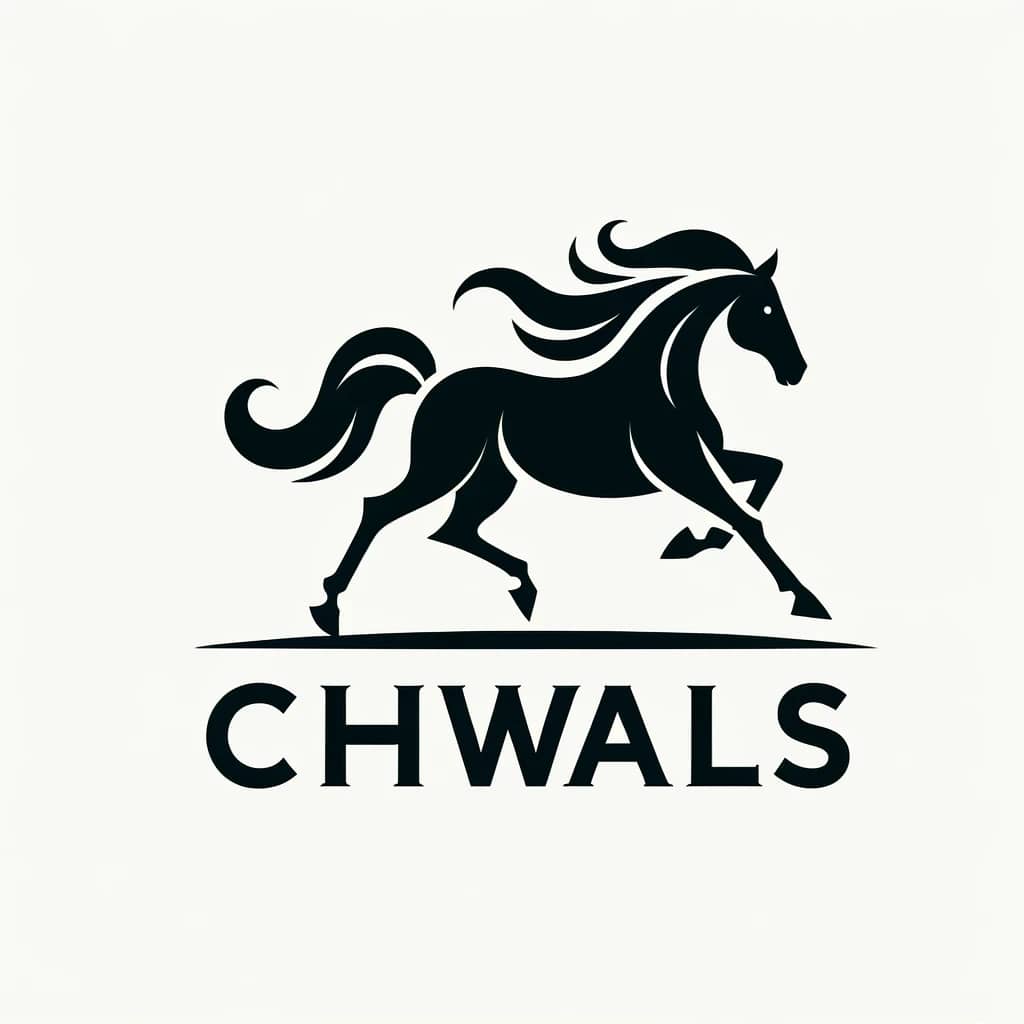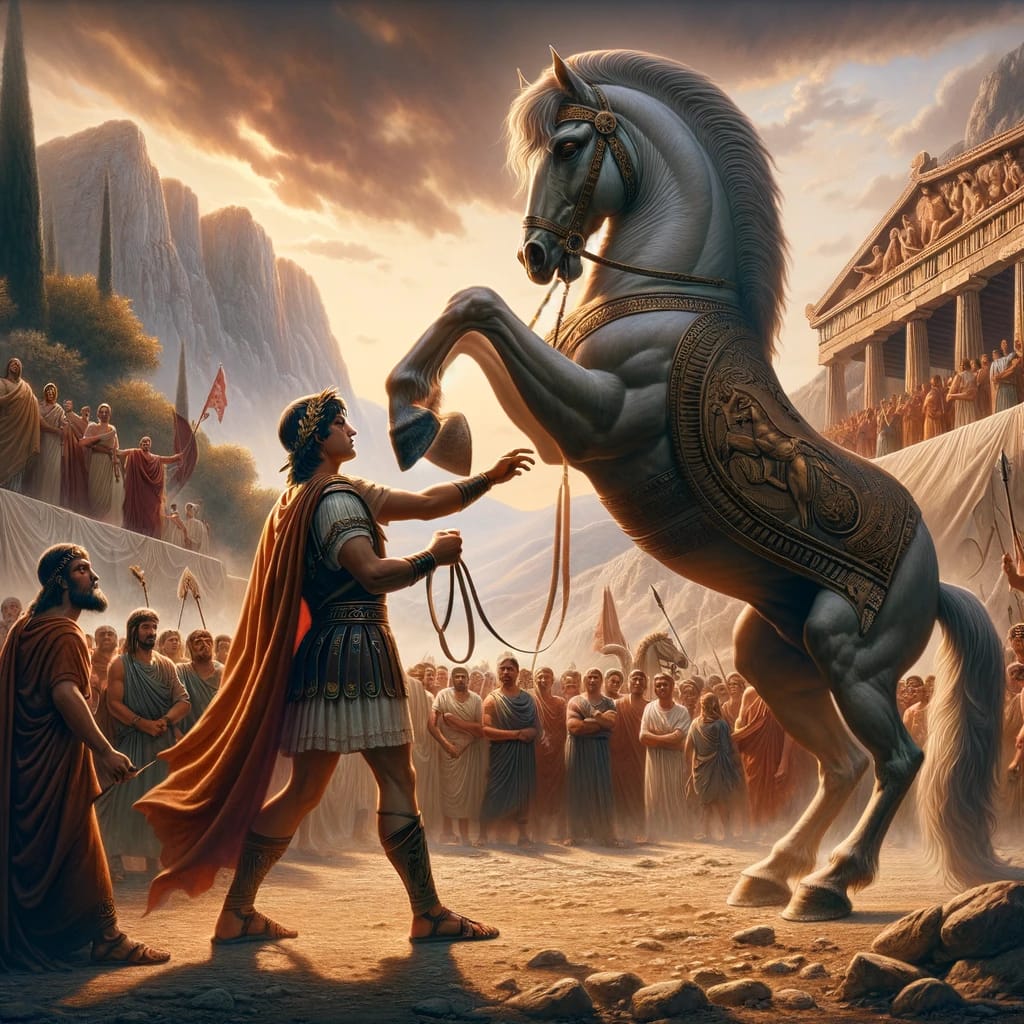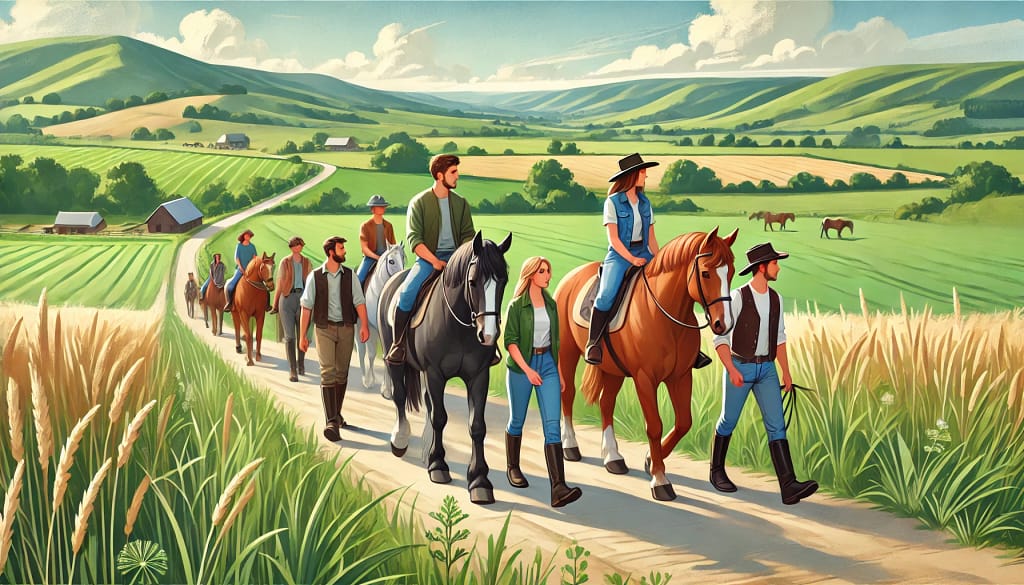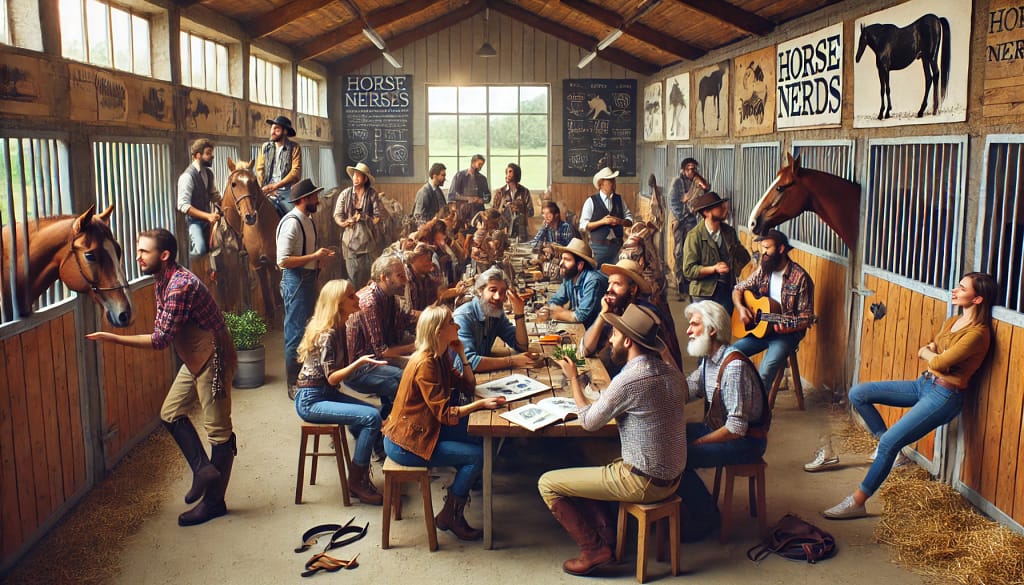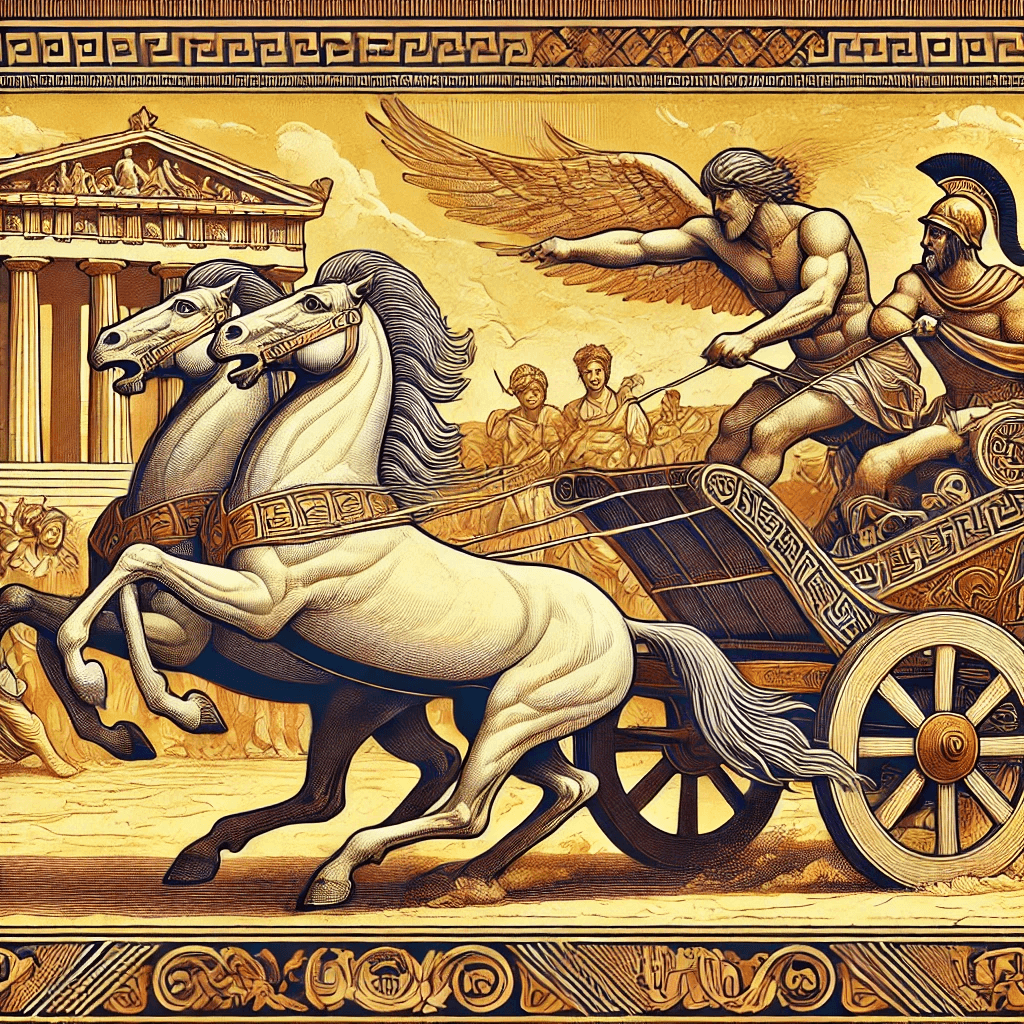
The oldest myth with horses
The oldest myth with horses in ancient Greek culture is often attributed to the tale of Pelops and the chariot race for the hand of Hippodamia. Allow me to take you on a journey through this ancient myth, spun with a touch of wit and the charm of a seasoned storyteller.
In the golden age of the ancient Greeks, where gods mingled with mortals and heroes etched their names in the annals of history, there was a young prince named Pelops. He was not just any prince; he was the son of Tantalus, a man infamous for his audacious attempts to deceive the gods. However, Pelops was determined to carve out his own destiny, one not overshadowed by his father’s misdeeds.
The story begins in the kingdom of Pisa, ruled by King Oenomaus, a man fiercely protective of his daughter, Hippodamia. The king, not one to shy away from showing off his power, declared that any suitor wishing to marry his daughter must first defeat him in a chariot race. The catch? If the suitor lost, he would lose more than just the race—his life would be forfeit. A rather grim deterrent, wouldn’t you say?
Hippodamia, renowned for her beauty and grace, was the apple of many a suitor’s eye, but the prospect of racing against her formidable father sent shivers down their spines. Oenomaus, aided by his divine horses gifted by Ares, had never lost a race. The suitors’ chariots often met with unfortunate “accidents,” leading to their untimely demise.
Enter Pelops, a prince with a glint of determination in his eyes and a heart full of audacious courage. Unlike the suitors before him, Pelops had a secret weapon: a favor from Poseidon, the god of the sea, who gifted him a magnificent chariot drawn by winged horses. With these divine steeds, Pelops felt confident enough to challenge the invincible king.
However, even with such divine assistance, Pelops knew the race would not be won by sheer speed alone. He needed an edge, something to tip the scales in his favor. So, with a sly grin, he sought out Myrtilus, the king’s charioteer, and offered him a tempting bribe. In exchange for sabotaging Oenomaus’s chariot, Myrtilus would receive half of the kingdom and a night with Hippodamia. Myrtilus, whose loyalty to Oenomaus was wavering, agreed to the deal.
The day of the race dawned with the sun casting a golden hue over the arena. The crowd gathered, buzzing with anticipation. Hippodamia watched with bated breath, her heart torn between fear and hope. The chariots lined up, and with a thunderous roar, they were off!
Oenomaus surged ahead, his horses flying like the wind. But unbeknownst to him, Myrtilus had replaced the bronze linchpins of his chariot with ones made of wax. As the race reached its climax, the heat from the sun melted the wax, and Oenomaus’s chariot fell apart, sending him tumbling to his doom.
Pelops, with his winged horses, soared past the finish line, victorious and alive. The crowd erupted in cheers, and Hippodamia’s heart swelled with joy. Yet, the tale does not end there. True to his word, Pelops rewarded Myrtilus, but when the treacherous charioteer tried to claim his night with Hippodamia, Pelops had him thrown into the sea, where he cursed Pelops and his descendants with his dying breath.
Thus, Pelops won his bride and founded a dynasty, but the curse of Myrtilus lingered, casting a shadow over his lineage. The story of Pelops’s race became legendary, a tale of wit, bravery, and the fickle favor of the gods, echoing through the ages and inspiring the very spirit of the Olympic Games.
Cultural and religious fabric of ancient Greece
The myth of Pelops and his fateful chariot race against King Oenomaus is deeply interwoven with the cultural and religious fabric of ancient Greece, shedding light on various aspects of their society, beliefs, and traditions.
Historical and Cultural Significance
- The Olympic Games: Pelops’s myth is intricately connected to the origins of the Olympic Games. According to legend, the games were founded by Pelops himself to commemorate his victory over Oenomaus. This myth provided a divine and heroic backdrop for the games, emphasizing themes of athleticism, competition, and honor. The games were held at Olympia, a site sacred to Zeus, further cementing their religious significance.
- Religion and the Gods: Ancient Greek culture was profoundly polytheistic, with gods and goddesses playing a central role in everyday life. The myth of Pelops highlights the intervention of the gods in mortal affairs. Poseidon’s gift of the winged horses to Pelops underscores the belief that divine favor was crucial for success. Additionally, the curses and blessings of the gods in the myth reflect the capricious nature of divine influence.
- Heroic Ideals: The myth exemplifies the heroic ideals celebrated in Greek culture. Pelops’s bravery, cunning, and determination are traits that ancient Greeks admired. Heroes were often depicted as individuals who could rise above ordinary mortals, achieving greatness through a combination of divine aid and personal valor.
- Moral Lessons and Themes: Embedded within the myth are themes of ambition, betrayal, and the consequences of one’s actions. Pelops’s pact with Myrtilus and the subsequent betrayal echo the complexities of human nature and morality. The curse of Myrtilus that haunts Pelops’s lineage serves as a reminder of the long-lasting repercussions of deceit and treachery.
Social and Ritual Practices
- Ritual Sacrifices: The myth also alludes to the practice of ritual sacrifices, which were a common aspect of ancient Greek religion. Pelops’s story, including the earlier gruesome tales of his father Tantalus’s sacrifices, reflects the importance of sacrificial rituals in appeasing the gods and seeking their favor.
- Funerary Games: The institution of the Olympic Games, as a form of funerary games for Oenomaus, indicates the cultural practice of honoring the dead through athletic competitions. These games were not just athletic contests but also religious ceremonies intended to honor the deceased and curry favor with the gods.
- Marriage and Dowry: The chariot race for Hippodamia’s hand in marriage highlights the significance of marriage alliances and the lengths to which suitors would go to secure a bride. It underscores the patriarchal structure of ancient Greek society, where the father’s approval and challenges dictated marital unions.
Artistic and Literary Influence
- Artistic Depictions: The myth of Pelops was a popular subject in ancient Greek art, depicted on pottery, friezes, and sculptures. These artistic representations served both as decorative elements and as a means of conveying cultural narratives and values. The scenes of the chariot race, with their dramatic tension, provided rich material for artists to explore themes of heroism and divine intervention.
- Literary Works: The myth was also a source of inspiration for ancient Greek playwrights and poets. It appears in various literary works, providing moral and dramatic context to stories that entertained and educated Greek audiences. These retellings and reinterpretations ensured the myth’s enduring presence in Greek cultural consciousness.
Conclusion
The myth of Pelops and the chariot race against Oenomaus is not merely a story of competition and divine favor but a tapestry that weaves together the religious beliefs, societal values, and artistic expressions of ancient Greece. It encapsulates the essence of Greek culture, where the mortal and divine intersect, and where heroic ideals are celebrated and immortalized in both word and art. This enduring myth continues to offer insights into the complexities and richness of ancient Greek civilization.
Online resources
For those interested in delving deeper into the history and contemporary aspects of equestrian events in the Olympic Games, both ancient and modern, there are numerous online resources available. Here are some comprehensive sources to explore:
Ancient Equestrian Olympic Games
- Perseus Digital Library:
- The Perseus Project offers a vast collection of primary and secondary sources related to ancient Greece, including texts on the Olympic Games and equestrian events.
- Perseus Digital Library
- The Ancient Olympics – Penn Museum:
- An educational resource that provides insights into the various events of the ancient Olympic Games, including chariot racing and other equestrian competitions.
- Penn Museum – The Ancient Olympics
- The British Museum:
- The British Museum’s collection includes artifacts and information about the ancient Olympics, with sections dedicated to equestrian sports.
- British Museum – Ancient Greece
Modern Equestrian Olympic Games
- International Olympic Committee (IOC):
- The official IOC website provides a comprehensive history of equestrian events in the modern Olympics, including detailed records and statistics.
- Olympic.org – Equestrian
- Fédération Équestre Internationale (FEI):
- The FEI is the governing body for equestrian sports worldwide and offers extensive information on current equestrian disciplines in the Olympics.
- FEI
- Team USA – Equestrian:
- For those specifically interested in the American equestrian team, this site offers profiles, news, and updates on athletes and events.
- Team USA – Equestrian
- Equestrian Federation of Australia (EFA):
- The EFA provides insights into the Australian equestrian team’s participation in the Olympics and other international events.
- Equestrian Australia
Academic and Research Resources
- JSTOR:
- A digital library for academic journals, books, and primary sources, JSTOR offers numerous scholarly articles on both ancient and modern equestrian sports.
- JSTOR
- Cambridge University Press:
- Cambridge offers various publications and research papers on the history of the Olympics, including equestrian sports.
- Cambridge University Press
- Google Scholar:
- A freely accessible search engine that indexes the full text or metadata of scholarly literature across an array of publishing formats and disciplines.
- Google Scholar
Interactive and Multimedia Resources
- Olympic Channel:
- The Olympic Channel provides videos, documentaries, and interviews with athletes, including those from equestrian sports.
- Olympic Channel
- YouTube:
- There are many channels and documentaries available on YouTube that cover both ancient Olympic history and modern equestrian events.
- YouTube – Olympic Equestrian
- Smithsonian Magazine:
- Offers articles and multimedia content on the history of the Olympics, including the evolution of equestrian events.
- Smithsonian Magazine – Olympics
These resources provide a blend of historical context, academic research, and current information, allowing for a comprehensive understanding of equestrian events in both ancient and modern Olympic Games. Whether you are a scholar, enthusiast, or casual learner, these platforms offer valuable insights and information.
